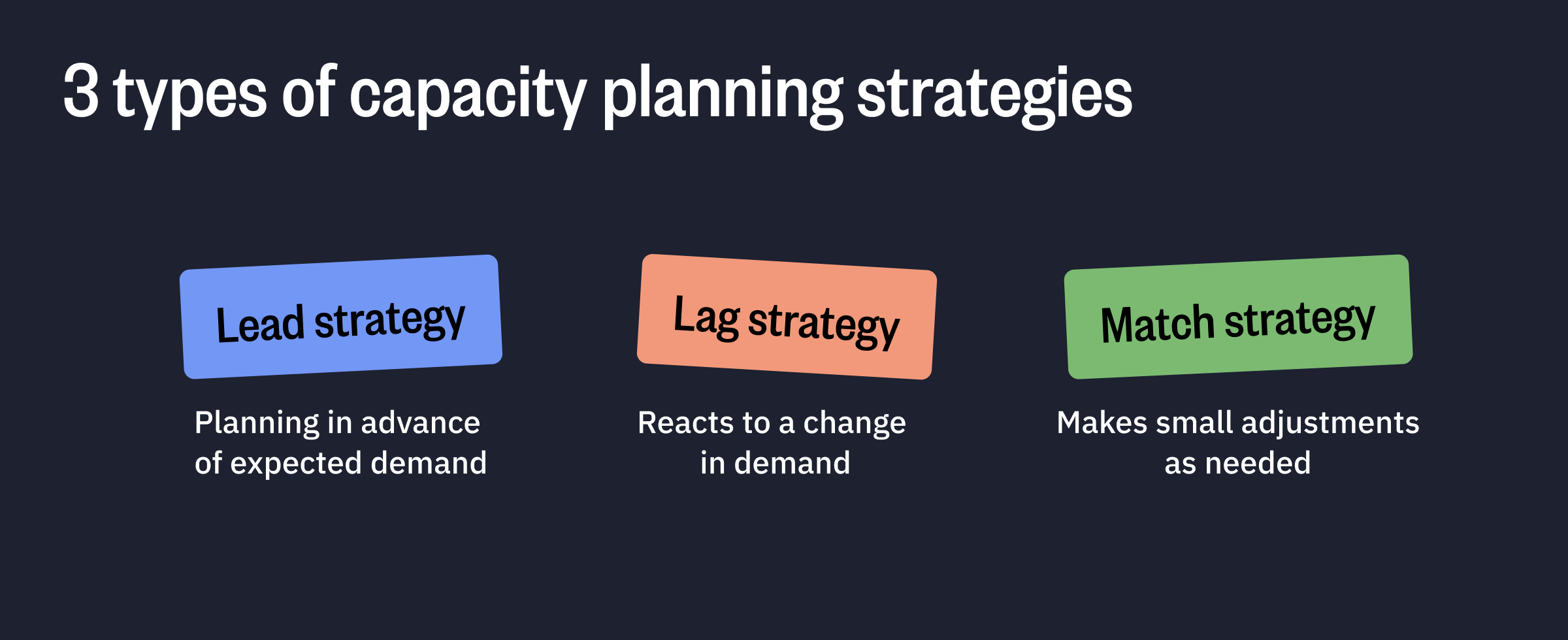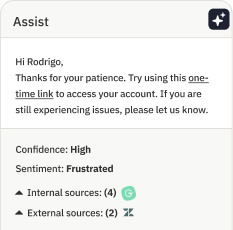How to refine your capacity planning process to ensure continued success

In all likelihood, you’ve been capacity planning in some form or another for your entire life. As a young child, you may have thought about whether you would need to ask a sibling for help to make sure you finished all your chores in time. When you were a student, you probably compared how many readings and papers you needed to complete in a weekend versus the total amount of time you could devote to those assignments.
Now that you’re in customer support, capacity planning is much more than a useful way to avoid trying to frantically compile a three-point essay in an hour.😅 It’s an essential process for determining how many resources you have, where they need to be deployed, and whether you need more to meet demand.
While you’ve probably been capacity planning for years, it’s always a good idea to look for ways you can improve. The more refined it is, the more efficient and effective your team will be. Ready to begin fine-tuning your capacity planning process? Comparing different strategies is a good place to start.
3 capacity planning strategies to consider
First, it’s worth pointing out that capacity planning isn’t relegated to the world of workforce management. It’s a critical process used by professionals who focus on supply chains, manufacturing, project management, recruiting talent, and more. That said, the different approaches to capacity planning are more or less the same.
While there's a bit of debate on precisely how many different capacity planning strategies exist, there are three types that are undoubtedly the most common for capacity planning at both a weekly and monthly level. Here’s a closer look at each:

Lead strategy: With a lead strategy, the goal is to always have enough resources to meet your forecasted demand. This means bringing on additional resources before an anticipated surge in contact volume, such as during the busy holiday return season. It’s often seen as riskier because there’s always a chance that there will be too many agents, meaning you aren’t efficiently staffed.
- Pro: Aligns with the type of long-term planning you already do
- Con: Possibility of excess capacity
- Pro: You have agents ready to go when volume picks up
Lag strategy: A lag strategy considers what’s happening right now, so resources are only adjusted when there’s an observed change in demand. It’s often seen as conservative because it can minimize the risk of wasting resources. However, it also means that a sudden surge in contact volume can leave agents overwhelmed and customers waiting for far longer than usual — and certainly beyond your target service levels. This can be a huge problem, even if your forecasts are only off for a few weeks.
- Con: Risk of overworking and burning out agents
- Pro: Minimizes the risk of bringing on resources you don’t need
- Con: Negatively affects the customer experience when contact volumes are high
Match strategy: You can think of a match strategy as a stepping-stone approach. The idea is to adjust capacity in small increments as you monitor trends and identify upcoming volume changes. Because a match strategy focuses on making small tweaks, you typically need to do capacity planning more frequently to ensure your resources are still aligned with demand.
- Con: Can be more complex to manage
- Pro: Offers flexibility and relatively low risk of overstaffing
- Con: Still somewhat reactive, leading to poor CX at times
Why a lead strategy is often preferable
While it’s important to weigh the benefits and drawbacks of each capacity planning strategy, almost every workforce management professional will benefit from a lead strategy. The other two are inherently reactive, meaning you’re constantly playing a game of catch-up. And when you find yourself facing a steep increase in contact volume, agents can quickly become overwhelmed. The result is a poor experience for both agents and customers.
Consider, for example, that your team has offered support via phone, SMS, and email for quite some time. Thanks to customer surveys, you’ve discovered that there’s an incredibly high demand for live chat. After months of receiving these responses, you decide to start leveraging this new channel of engagement. If you're operating under a lag or match strategy, it’s easy to see how your agents could quickly find themselves underwater the moment live chat becomes available.
But is a lead strategy really that beneficial? Take a look at a few real-life examples that illustrate what’s possible by taking a more proactive approach to capacity planning.
A case study published in the Journal of Nursing Management shows how impactful a lead strategy can be for healthcare systems. The report reveals that evaluating historical data to forecast predicted absences yielded highly accurate forecasts that could be used to optimize staffing. The result? Annual cost savings of $277,683.
McKinsey & Company has also highlighted a few success stories that stem from taking a proactive approach to capacity planning, which accounts for seasonality and other drivers of demand spikes, combined with dynamic dispatching for a few field teams. With this strategy, a telecommunications company was able to increase productivity by 40% within a year. A utility company saw similar results, boasting a 20% increase in productivity and a 50% increase in customer satisfaction.
While you might be tempted to think that your team is too small to require a lead strategy, the benefits are hard to ignore. And when your team isn’t quite so small anymore, you’ll be glad you went with the proactive approach to capacity planning.
How to fine-tune your capacity planning process
Capacity planning is undoubtedly important for ensuring long-term success for both your team and your organization, but getting it right doesn’t necessarily happen naturally. In fact, an IDG survey that polled more than 150 IT leaders found that 86% said it was very or extremely challenging to optimize their resource capacity to meet business demands.

Success is absolutely within reach — you just need to be strategic about establishing a sound capacity planning process and identifying ways to continually improve it over time. First things first, start by building your foundation.
Begin by establishing a solid capacity planning process
Whether you’re looking to overhaul your capacity planning process or not, it’s always helpful for a quick refresher on what a healthy capacity planning process involves. If your company is already leveraging a workforce management platform, some parts will go really fast. But you can also dive into capacity planning by leveraging some spreadsheets as you walk through each of the below steps.
- Calculate your required staffing level — Done right, capacity planning provides you with an accurate look at a week in a digestible format. To get there, you’ll need to forecast your contact volume for about three to 18 months, then break them down into weekly forecasts that take into account factors like growth in your customer base and seasonality. Next, calculate your required staffing level by multiplying your contact volume by the average handle time to get the total number of hours of work.
- Plan your staffing accordingly — The next step is to map out your agent headcount. Key parts of this include reducing overall headcount by expected attrition, which you can arrive at by dividing your annualized attrition rate by 52 (weeks in the year). You’ll also need to reduce hours to account for shrinkage, and 35% is usually a good rule of thumb. Lastly, you need to map in planned new hires and the time it takes to recruit and onboard them.
- Model multiple scenarios to be as comprehensive as possible — To ensure your model is as useful as possible, adjust the inputs to see how your numbers change. You might consider testing out different agent onboarding timelines, attrition rates, or contact volumes. Doing this will give you a range that you can feel confident about.
- Identify ways to balance gaps in staffing — You likely have agents who specialize in particular channels, such as email + chat versus being fully dedicated to phone. If you’re modeling multiple channels, take some time to compare surpluses and deficits across each. If your phones are overstaffed, perhaps you can alleviate other teams by reallocating those agents.
- Build reports that can be used by stakeholders — Once you’ve run your calculations, build out big-picture reports you can distribute to leaders across the organization, including those who work on the finance team, the HR team, etc. It’s also a good idea to consider adding some color commentary related to the types of questions these individuals will ask, such as what the primary drivers of cost changes are.
Define the objectives you want to achieve
There are numerous benefits of capacity planning: reducing agent stress and enhancing morale, fueling efficiency, improving hiring decisions, identifying skill gaps, and so on. But to really refine your capacity planning process in the way that provides the most value to your organization, you need to figure out what purpose it’s truly serving.
Think of it this way: Why are you engaged in capacity planning? Maybe it’s to help build out a two-year operating budget. Or perhaps you need to determine the right times at which to hire new team members.
Priorities will vary from one team to another, so make sure you understand where to focus by speaking to leadership and understanding their expectations. From there, it will be far easier to identify which objectives you should be working toward.
Bear in mind that loosely defined goals don’t do much to keep your team motivated or convey the progress you’ve made. As corny as it is, a tried-and-true goal methodology known as SMART can really help you to refine your goals and optimize your team’s performance.
While it’s tough to pin down exactly where the concept of SMART goals comes from, the first documented explanation appeared in a 1981 paper written by George T. Doran. Effectively, this paper was focused on providing a useful framework for managers to set goals. Now for the acronym itself:
☝️ Specific: The goal should be focused rather than trying to lump a number of goals together.
📏 Measurable: There needs to be a clear way to track progress and measure success.
🌟 Achievable: It must be attainable — not easy, but attainable.
🔗 Relevant: Goals should always, always be connected to your organization's larger objectives.
⏳ Time-bound: There must be a deadline that allows you to determine whether you’ve reached your goal.
With both an area of focus and the SMART framework in mind, you can go about actually setting specific goals. Some of them will align with the customer service metrics you’re already tracking. Here are a few examples to get your wheels turning:
- Increase CSAT scores by 20% by the end of the fiscal year
- Improve agent adherence from 88% to 90% during the upcoming quarter
- Decrease agent attrition by 10% over the next two years
Refine your capacity planning process by adjusting inputs
As you become increasingly confident in your capacity planning abilities, you’ll be able to enhance your process so that it aligns more closely with the goals you’ve identified. Start by evaluating each cycle you’ve mapped out, then tease out which inputs aren’t quite aligning with your expectations.
Take your time when studying each input, because trends will start to emerge once you dig into the details. Maybe your actual volume is 15% lower than expected. Or it could be that your attrition spiked during the summer more than it has in the past four years.
Bear in mind that there are many factors, not just the inputs themselves, that ultimately affect capacity planning. Wolters Kluwer outlines a number of them, including:
- Agents’ skills
- Quality capabilities
- Training/shrinkage
- Turnover rates
- Governmental policies
- Budget cycles
It’s important to keep these elements in mind as you adjust your capacity planning process because they’ll affect the outcomes. Take agents’ skills, for example. If 25% of your staff needs to work on conveying a more empathetic, personalized tone that puts customers at ease, they could very easily have higher average handle times than more tenured agents.
As you can see, the job is truly never complete when it comes to capacity planning. Rather than viewing it as reaching a final destination, think of it as a regular exercise. Even the top-performing teams have room for improvement. Research from Planview actually shows that 89% of leading companies say it’s possible for them to improve on making decisions and executing faster. Additionally, 49% of those same leading companies intend to improve the speed at which they realign resources to new priorities.
Just remember, if you’re thinking about how you can fine-tune your capacity planning process, you’re already in a great position. It’s just a matter of going from great to exceptional.✨
Take the next step toward streamlining capacity planning
With the right strategy, a sound process, and clearly defined goals, you’re equipped to engage in capacity planning in a way that provides real value to your organization. Everything from hiring to hitting SLAs is much simpler. Even communicating with executives becomes easier when you’re able to back up your recommendations with reports that are chock-full of concrete numbers.
You don’t even need any advanced tools to refine your capacity planning process. That said, having a sophisticated platform that allows you to easily build and adjust precise forecasts can make the job that much easier.
Discover what’s possible with an actionable forecasting solution.





